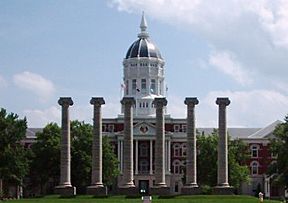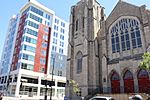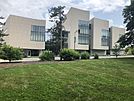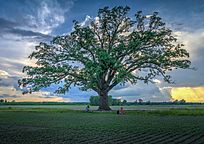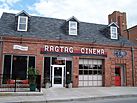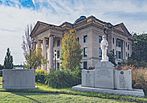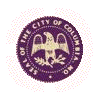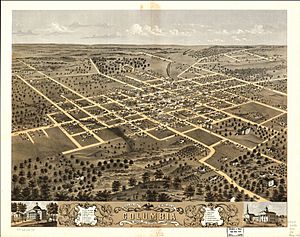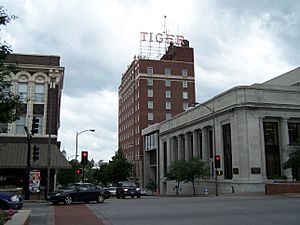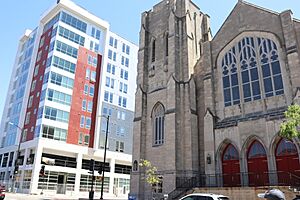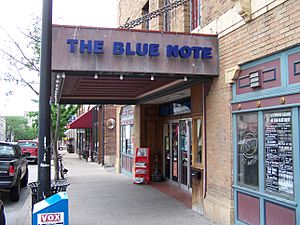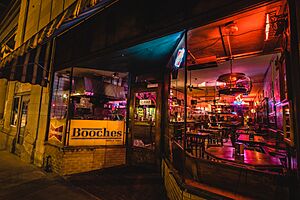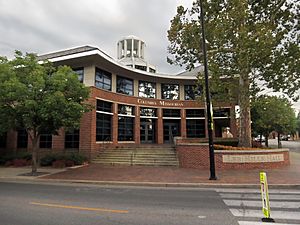Columbia, Missouri facts for kids
Quick facts for kids
Columbia, Missouri
|
|||
|---|---|---|---|
|
Missouri United Methodist Church
Memorial Union
Boone County Courthouse
|
|||
|
|||
| Nicknames:
"The Athens of Missouri", or CoMo
|
|||
| Country | United States | ||
| State | Missouri | ||
| County | Boone | ||
| Founded | 1821 | ||
| Incorporated | 1826 | ||
| Named for | Columbia | ||
| Government | |||
| • Type | Council–manager | ||
| • Body | Columbia City Council | ||
| Area | |||
| • Total | 67.45 sq mi (174.70 km2) | ||
| • Land | 67.17 sq mi (173.98 km2) | ||
| • Water | 0.28 sq mi (0.72 km2) | ||
| Elevation | 761 ft (232 m) | ||
| Population
(2020)
|
|||
| • Total | 126,254 | ||
| • Estimate
(2023)
|
129,330 | ||
| • Rank | US: 222nd MO: 4th |
||
| • Density | 1,879.48/sq mi (725.67/km2) | ||
| • Metro | 210,864 (216th) | ||
| • CSA | 410,851 (102nd) | ||
| Demonym(s) | Columbian | ||
| Time zone | UTC−6 (CST) | ||
| • Summer (DST) | UTC−5 (CDT) | ||
| ZIP Codes |
65201, 65202, 65203, 65211
|
||
| Area code(s) | 573 | ||
| FIPS code | 29-15670 | ||
| GNIS feature ID | 2393605 | ||
Columbia is a city in Missouri, United States. It was founded in 1821 as the county seat of Boone County and had a population of 126,254 as recorded in the 2020 census, making it the fourth-most populous city in Missouri. Columbia is a Midwestern college town, home to the University of Missouri, a major research institution also known as MU or Mizzou. In addition to the university and surrounding Downtown Columbia are Stephens College and Columbia College, giving the city its educational focus and nearly 40,000 college students. It is the principal city of the Columbia metropolitan area, population 215,811, and the central city of the nine-county Columbia–Jefferson City–Moberly combined statistical area with 415,747 residents. The city is the fastest growing municipality in Missouri, with a growth of almost 40% since 2000, and a population estimated at 130,000 in 2024. Columbia is among the most-educated cities in the United States with about half of citizens being college graduates and about a quarter holding advance degrees.
The city is built on the oak-forested hills and rolling prairies of Mid-Missouri, near the Missouri River, where the Ozark Mountains transition into plains and savanna. At the city's center is the Avenue of the Columns (8th Street), connecting Francis Quadrangle and Jesse Hall to the Boone County Courthouse and the City Hall. Surrounding Columbia is a greenbelt including Rock Bridge Memorial State Park, Eagle Bluffs Conservation Area, the Mark Twain National Forest, Katy Trail State Park, Finger Lakes State Park, and the Big Muddy National Fish and Wildlife Refuge. Limestone bedrock forms bluffs and glades while rain dissolves the bedrock, creating karst (caves and springs) which water the Hinkson, Roche Perche, Flat Branch, and Bonne Femme creeks. Within city limits, there is an extensive city parks and trails system with a focus on non-motorized transportation, including the MKT Trail. The Columbia Agriculture Park is home to the nationally-regarded Columbia Farmers Market.
Originally an agricultural town, education and healthcare are now Columbia's primary economic concern, with secondary interests in the insurance, finance, and technology sectors. Companies founded in Columbia include: Carfax, Shelter Insurance, Veterans United Home Loans, MFA Incorporated, MFA Oil, Slackers CDs and Games, MidwayUSA, EquitmentShare, and Scripps News. The University of Missouri Health Care system operates six hospitals in Columbia, several clinics, and The Thompson Center for Autism and Neurodevelopment. There is also the county-owned Boone Hospital Center, several smaller private hospitals, and the Harry S. Truman Veterans' Hospital, adjacent to University Hospital and MU School of Medicine. The University of Missouri nuclear reactor is the most-powerful research reactor in the United States and the sole supplier of important radioisotopes used in nuclear medicine.
Cultural institutions include the State Historical Society of Missouri, the Museum of Art and Archaeology, the Missouri Symphony, the North Village Arts District, The Blue Note, the Missouri Theatre, The Conservatory of the Performing Arts at Stephens College, the Boone County Historical Society, Columbia Public Library, Ragtag Cinema and the annual True/False Film Festival, an internationally-known documentary festival. The Missouri Tigers, the state's only major college athletic program, play football at Faurot Field and basketball at Mizzou Arena as members of the Southeastern Conference (SEC). The city has been known as the "Athens of Missouri" for its educational emphasis and classic beauty, but is more commonly called "CoMo".
Contents
History
The Columbia area was once part of the Mississippian culture and home to the Mound Builders. When European explorers arrived, the area was populated by the Osage and Missouri Indians. In 1678, La Salle claimed all of Missouri for France. The Lewis and Clark Expedition passed by the area on the Missouri River in early June 1804. In 1806, two sons of Daniel Boone established a salt lick 40 miles (64 km) northwest of Columbia. giving the area its early name: Boonslick. The Boone's Lick Trail wound from St. Charles to the lick in present-day Howard County. In 1818, a group of settlers, incorporated under the Smithton Land Company, purchased over 2,000 acres (8.1 km2) and established the village of Smithton less than a mile from current day downtown Columbia. In 1821, the settlers moved, because of lack of water, across the Flat Branch to the plateau between the Flat Branch and Hinkson creeks in what is now the downtown district. They renamed the settlement Columbia—a poetic personification of the United States.
The roots of Columbia's three economic foundations—education, medicine, and insurance—can be traced back to incorporation in 1821. Original plans for the town set aside land for a state university. In 1833, Columbia Baptist Female College opened, which later became Stephens College. Columbia College (distinct from today's), later to become the University of Missouri, was founded in 1839. When the state legislature decided to establish a state university, Columbia raised three times as much money as any other competing city and James S. Rollins donated the land that is today the Francis Quadrangle. Soon other educational institutions were founded in Columbia such as Christian Female College, the first college for women west of the Mississippi, which later became the current Columbia College. The city benefited from being a stagecoach stop of the Santa Fe and Oregon trails, and later from the Missouri-Kansas-Texas Railroad. In 1822 the first hospital was set up by William Jewell. In 1830, the first newspaper began; in 1832, the first theater in the state was opened; and in 1835, the state's first agricultural fair was held. By 1839, the population (13,000) and wealth of Boone County was exceeded in Missouri only by that of St. Louis County, which at that time included the City of St. Louis.
Columbia's infrastructure was relatively untouched by the Civil War. Missouri, as a slave state, had Southern sympathies, but remained in the Union. The majority of the city was pro-Union, however, the surrounding agricultural areas of Boone County and the rest of central Missouri were decidedly pro-Confederate. Because of this, the University of Missouri became a base from which Union troops operated. No battles were fought within the city because the presence of Union troops dissuaded Confederate guerrillas from attacking, though several major battles occurred nearby at Boonville and Centralia.
In 1963, Columbia become home to the headquarters of both the University of Missouri System, which today serves over 77,000 students, and the Columbia College system, which today serves about 25,000 students. The insurance industry also became important to the local economy as several companies established headquarters in Columbia, including Shelter Insurance, Missouri Employers Mutual, and Columbia Insurance Group. State Farm Insurance has a regional office in Columbia. In addition, the now defunct Silvey Insurance was once a large local employer. Columbia became a transportation crossroads when U.S. Route 63 and U.S. Route 40 (which became present-day Interstate 70) were routed through the city. Soon after the city opened the Columbia Regional Airport. The latter 20th century saw tremendous growth, and by 2000 the population was nearly 85,000 in the city proper.
In early 2006, Columbia embarked on a plan to manage the continued growth as the city approached (and passed) 100,000 population. The city continues to grow, especially east around the newly opened Battle High School. The downtown district has maintained its status as a cultural center and is undergoing significant development in both residential and commercial sectors. The University of Missouri, which has tremendous economic impact on the city, experienced record enrollment in 2006 and is undertaking significant construction.
Geography
Columbia, located in northern mid-Missouri, is 120 miles (190 km) away from both St. Louis and Kansas City, and 29 miles (47 km) north of the state capital Jefferson City. The city is near the Missouri River between the Ozark Plateau and the Northern Plains. Trees are mainly oak, maple, and hickory; common understory trees include eastern redbud, serviceberry, and flowering dogwood. Riparian areas are forested with mainly American sycamore. Much of the residential area of the city is planted with large native shade trees. In Autumn, the changing color of the trees is notable. Most species here are typical of the Eastern Woodland.
According to the United States Census Bureau, the city has a total area of 63.5 square miles (164.46 km2), of which, 63.08 square miles (163.38 km2) is land and 0.42 square miles (1.09 km2) is water.
Topography
The city generally slopes from the highest point in the Northeast to the lowest point in the Southwest towards the Missouri River. Prominent tributaries of the river are Perche Creek, Hinkson Creek, and Flat Branch Creek. Along these and other creeks in the area can be found large valleys, cliffs, and cave systems such as that in Rock Bridge State Park just south of the city. These creeks are largely responsible for numerous stream valleys giving Columbia hilly terrain similar to the Ozarks while also having prairie flatland typical of northern Missouri. Columbia also operates several greenbelts with trails and parks throughout town.
Animal life
Large mammals found in the city includes urbanized coyotes and numerous whitetail deer. Eastern gray squirrel, and other rodents are abundant, as well as cottontail rabbits and the nocturnal opossum and raccoon. Large bird species are abundant in parks and include the Canada goose, mallard duck, as well as shorebirds, including the great egret and great blue heron. Turkeys are also common in wooded areas and can occasionally be seen on the MKT recreation trail. Populations of bald eagles are found by the Missouri River. The city is on the Mississippi Flyway, used by migrating birds, and has a large variety of small bird species, common to the eastern U.S. The Eurasian tree sparrow, an introduced species, is limited in North America to the counties surrounding St. Louis. Columbia has large areas of forested and open land and many of these areas are home to wildlife.
Frogs are commonly found in the springtime, especially after extensive wet periods. Common species include the American toad and species of chorus frogs, commonly called "spring peepers" that are found in nearly every pond. Some years have outbreaks of cicadas or ladybugs. Mosquitos and houseflies are common insect nuisances; because of this, windows are nearly universally fitted with screens, and "screened-in" porches are common in homes of the area.
Climate
Columbia has a climate marked by sharp seasonal contrasts in temperature, falling between a humid continental and humid subtropical climate (Köppen Dfa/Cfa, respectively), and is located in USDA Plant Hardiness Zone 6a. The monthly daily average temperature ranges from 29.7 °F (−1.3 °C) in January to 77.3 °F (25.2 °C) in July, while the high reaches or exceeds 90 °F (32 °C) on an average 32 days per year, 100 °F (38 °C) on 2.0 days, while 4.0 nights of sub-0 °F (−18 °C) lows can be expected. Precipitation tends to be greatest and most frequent in the latter half of spring, when severe weather is also most common. Snow averages 18.0 inches (46 cm) per season, mostly from December to March, with occasional November accumulation and falls in April being rarer; historically seasonal snow accumulation has ranged from 3.4 in (8.6 cm) in 2005–06 to 54.9 in (139 cm) in 1977–78. Extreme temperatures have ranged from −26 °F (−32 °C) on February 12, 1899 to 113 °F (45 °C) on July 12 and 14, 1954. Readings of −10 °F (−23 °C) or 105 °F (41 °C) are uncommon, the last occurrences being January 7, 2014 and July 31, 2012.
| Climate data for Columbia Regional Airport, Missouri (1981–2010 normals, extremes 1889–present) | |||||||||||||
|---|---|---|---|---|---|---|---|---|---|---|---|---|---|
| Month | Jan | Feb | Mar | Apr | May | Jun | Jul | Aug | Sep | Oct | Nov | Dec | Year |
| Record high °F (°C) | 77 (25) |
82 (28) |
92 (33) |
93 (34) |
101 (38) |
107 (42) |
113 (45) |
110 (43) |
104 (40) |
96 (36) |
84 (29) |
76 (24) |
113 (45) |
| Mean maximum °F (°C) | 61.9 (16.6) |
69.0 (20.6) |
79.0 (26.1) |
84.8 (29.3) |
86.9 (30.5) |
92.3 (33.5) |
96.9 (36.1) |
98.4 (36.9) |
91.5 (33.1) |
84.1 (28.9) |
74.4 (23.6) |
63.8 (17.7) |
99.5 (37.5) |
| Mean daily maximum °F (°C) | 38.5 (3.6) |
43.9 (6.6) |
55.2 (12.9) |
66.1 (18.9) |
74.5 (23.6) |
83.0 (28.3) |
87.6 (30.9) |
87.0 (30.6) |
78.8 (26.0) |
67.1 (19.5) |
53.9 (12.2) |
41.1 (5.1) |
64.8 (18.2) |
| Mean daily minimum °F (°C) | 20.9 (−6.2) |
24.9 (−3.9) |
34.0 (1.1) |
44.0 (6.7) |
53.5 (11.9) |
62.8 (17.1) |
67.0 (19.4) |
65.4 (18.6) |
56.4 (13.6) |
45.0 (7.2) |
34.9 (1.6) |
23.7 (−4.6) |
44.5 (6.9) |
| Mean minimum °F (°C) | 0.3 (−17.6) |
3.9 (−15.6) |
15.6 (−9.1) |
28.3 (−2.1) |
39.8 (4.3) |
50.8 (10.4) |
57.1 (13.9) |
54.9 (12.7) |
39.8 (4.3) |
29.4 (−1.4) |
17.9 (−7.8) |
3.5 (−15.8) |
−6.3 (−21.3) |
| Record low °F (°C) | −20 (−29) |
−26 (−32) |
−9 (−23) |
14 (−10) |
28 (−2) |
40 (4) |
45 (7) |
40 (4) |
26 (−3) |
19 (−7) |
−3 (−19) |
−23 (−31) |
−26 (−32) |
| Average precipitation inches (mm) | 1.92 (49) |
2.25 (57) |
2.91 (74) |
4.49 (114) |
4.98 (126) |
4.47 (114) |
4.37 (111) |
4.36 (111) |
3.87 (98) |
3.31 (84) |
3.25 (83) |
2.44 (62) |
42.62 (1,083) |
| Average snowfall inches (cm) | 6.1 (15) |
4.7 (12) |
1.7 (4.3) |
0.2 (0.51) |
0 (0) |
0 (0) |
0 (0) |
0 (0) |
0 (0) |
0 (0) |
0.9 (2.3) |
4.4 (11) |
18.0 (46) |
| Average precipitation days (≥ 0.01 in) | 7.7 | 8.0 | 10.6 | 10.8 | 12.5 | 9.7 | 8.8 | 8.6 | 8.1 | 9.5 | 9.7 | 8.4 | 112.4 |
| Average snowy days (≥ 0.1 in) | 3.6 | 3.3 | 1.3 | 0.2 | 0 | 0 | 0 | 0 | 0 | 0 | 1.0 | 2.5 | 11.9 |
| Average relative humidity (%) | 71.2 | 71.5 | 67.3 | 63.9 | 70.9 | 71.3 | 69.5 | 70.8 | 71.7 | 69.4 | 71.8 | 74.0 | 70.3 |
| Mean monthly sunshine hours | 161.5 | 154.3 | 193.5 | 226.9 | 264.1 | 294.1 | 313.4 | 288.5 | 229.1 | 210.7 | 150.6 | 140.3 | 2,627 |
| Percent possible sunshine | 53 | 51 | 52 | 57 | 60 | 66 | 69 | 68 | 61 | 61 | 50 | 48 | 59 |
| Source: NOAA (relative humidity 1969–1990, sun 1961–1990) | |||||||||||||
Cityscape
Columbia's most significant and well-known architecture is found in buildings located in its downtown area and on the university campuses. The University of Missouri's Jesse Hall and the neo-Gothic Memorial Union have become icons of the city. The David R. Francis Quadrangle is an example of Thomas Jefferson's academic village concept.
Nine historic districts located within the city are listed on the National Register of Historic Places: Downtown Columbia, the East Campus neighborhood, the West Broadway neighborhood, the Francis Quadrangle, the south campus of Stephens College, the Pierce Pennant Motor Hotel, Maplewood, and the David Guitar House. The downtown skyline is relatively low and is dominated by the 10-story Tiger Hotel and the 15-story Paquin Tower.
Downtown Columbia is an area of approximately one square mile surrounded by the University of Missouri on the south, Stephens College to the east, and Columbia College on the north. The area serves as Columbia's financial and business district.
Since the early-21st century, a large number of high-rise apartment complexes have been built in downtown Columbia. Many of these buildings also offer mixed-use business and retail space on the lower levels. These developments have not been without criticism, with some expressing concern the buildings hurt the historic feel of the area, or that the city does not yet have the infrastructure to support them.
The city's historic residential core lies in a ring around downtown, extending especially to the west along Broadway, and south into the East Campus Neighborhood. The city government recognizes 63 neighborhood associations. The city's most dense commercial areas are primarily along Interstate 70, U.S. Route 63, Stadium Boulevard, Grindstone Parkway, and Downtown.
Demographics
| Historical population | ||
|---|---|---|
| Year | Pop. | ±% |
| 1823 | 130 | — |
| 1830 | 600 | +361.5% |
| 1840 | 750 | +25.0% |
| 1850 | 651 | −13.2% |
| 1860 | 1,414 | +117.2% |
| 1870 | 2,236 | +58.1% |
| 1880 | 3,326 | +48.7% |
| 1890 | 4,000 | +20.3% |
| 1900 | 5,651 | +41.3% |
| 1910 | 9,662 | +71.0% |
| 1920 | 10,392 | +7.6% |
| 1930 | 14,967 | +44.0% |
| 1940 | 18,399 | +22.9% |
| 1950 | 31,974 | +73.8% |
| 1960 | 36,650 | +14.6% |
| 1970 | 58,521 | +59.7% |
| 1980 | 62,061 | +6.0% |
| 1990 | 69,101 | +11.3% |
| 2000 | 84,531 | +22.3% |
| 2010 | 108,500 | +28.4% |
| 2020 | 126,254 | +16.4% |
| 2023 | 129,330 | +2.4% |
| For the year 1850, slaves and free minorities were not counted. U.S. Decennial Census Source: |
||
2020 census
The 2020 United States census counted 126,254 people, 49,371 households, and 25,144 families in Columbia. The population density was 1,879.6 inhabitants per square mile (725.7/km2). There were 53,746 housing units at an average density of 800.1 per square mile (308.9/km2). The racial makeup (including Hispanics in the racial counts) was 72.49% (91,516) white, 11.91% (15,038) black or African-American, 0.32% (398) Native American, 5.61% (7,084) Asian, 0.07% (89) Pacific Islander, 2.17% (2,734) from other races, and 7.44% (9,395) from two or more races. Hispanic or Latino of any race was 4.9% (6,195) of the population.
Of the 49,371 households, 24.0% had children under the age of 18; 38.7% were married couples living together; 31.4% had a female householder with no husband present. Of all households, 34.7% were individuals and 8.6% had someone living alone who was 65 years of age or older. The average household size was 2.3 and the average family size was 3.0.
18.2% of the population was under the age of 18, 23.8% from 18 to 24, 26.4% from 25 to 44, 18.0% from 45 to 64, and 10.7% who were 65 years of age or older. The median age was 28.8 years. For every 100 females, the population had 93.3 males. For every 100 females ages 18 and older, there were 89.8 males.
The 2016-2020 5-year American Community Survey estimates show that the median household income was $53,447 (with a margin of error of +/- $2,355) and the median family income $81,392 (+/- $5,687). Males had a median income of $30,578 (+/- $2,131) versus $23,705 (+/- $1,849) for females. The median income for those above 16 years old was $26,870 (+/- $1,429). Approximately, 8.5% of families and 20.2% of the population were below the poverty line, including 15.7% of those under the age of 18 and 5.2% of those ages 65 or over.
| Race / Ethnicity (NH = Non-Hispanic) | Pop 2000 | Pop 2010 | Pop 2020 | % 2000 | % 2010 | % 2020 |
|---|---|---|---|---|---|---|
| White alone (NH) | 67,984 | 83,542 | 89,814 | 80.42% | 77.00% | 71.14% |
| Black or African American alone (NH) | 9,106 | 12,083 | 14,858 | 10.77% | 11.14% | 11.77% |
| Native American or Alaska Native alone (NH) | 303 | 296 | 273 | 0.36% | 0.27% | 0.22% |
| Asian alone (NH) | 3,624 | 5,604 | 7,056 | 4.29% | 5.16% | 5.59% |
| Pacific Islander alone (NH) | 29 | 59 | 87 | 0.03% | 0.05% | 0.07% |
| Some Other Race alone (NH) | 174 | 227 | 724 | 0.21% | 0.21% | 0.57% |
| Mixed Race or Multi-Racial (NH) | 1,578 | 2,960 | 7,247 | 1.87% | 2.73% | 5.74% |
| Hispanic or Latino (any race) | 1,733 | 3,729 | 6,195 | 2.05% | 3.44% | 4.91% |
| Total | 84,531 | 108,500 | 126,254 | 100.00% | 100.00% | 100.00% |
2010 census
As of the census of 2010, 108,500 people, 43,065 households, and 21,418 families resided in the city. The population density was 1,720.0 inhabitants per square mile (664.1/km2). There were 46,758 housing units at an average density of 741.2 per square mile (286.2/km2). The racial makeup of the city was 79.0% White, 11.3% African American, 0.3% Native American, 5.2% Asian, 0.1% Pacific Islander, 1.1% from other races, and 3.1% from two or more races. Hispanic or Latino of any race were 3.4% of the population.
There were 43,065 households, of which 26.1% had children under the age of 18 living with them, 35.6% were married couples living together, 10.6% had a female householder with no husband present, 3.5% had a male householder with no wife present, and 50.3% were non-families. 32.0% of all households were made up of individuals, and 6.6% had someone living alone who was 65 years of age or older. The average household size was 2.32 and the average family size was 2.94.
In the city the population was spread out, with 18.8% of residents under the age of 18; 27.3% between the ages of 18 and 24; 26.7% from 25 to 44; 18.6% from 45 to 64; and 8.5% who were 65 years of age or older. The median age in the city was 26.8 years. The gender makeup of the city was 48.3% male and 51.7% female.
Economy
Columbia's economy is historically dominated by education, healthcare, and insurance. Jobs in government are also common, either in Columbia or a half-hour south in Jefferson City. The Columbia Regional Airport and the Missouri River Port of Rocheport connect the region with trade and transportation.
With a Gross Metropolitan Product of $9.6 billion in 2018, Columbia's economy makes up 3% of the Gross State Product of Missouri. Columbia's metro area economy is slightly larger than the economy of Rwanda. Insurance corporations headquartered in Columbia include Shelter Insurance and the Columbia Insurance Group. Other organizations include StorageMart, Veterans United Home Loans, MFA Incorporated, the Missouri State High School Activities Association, and MFA Oil. Companies such as Socket, Datastorm Technologies, Inc. (no longer existent), Slackers CDs and Games, Carfax, and MBS Textbook Exchange were all founded in Columbia.
Top employers
According to Columbia's 2022 Annual Comprehensive Financial Report, the top employers in the city are:
| # | Employer | # of Employees | % of Total City Employment |
|---|---|---|---|
| 1 | University of Missouri | 8,709 | 9.07% |
| 2 | University of Missouri Health Care | 5,092 | 5.30% |
| 3 | Veterans United Home Loans | 3,474 | 3.62% |
| 4 | Columbia Public Schools | 2,650 | 2.76% |
| 5 | Harry S. Truman Memorial Veterans' Hospital | 1,779 | 1.85% |
| 6 | Boone Hospital Center | 1,581 | 1.65% |
| 7 | City of Columbia | 1,515 | 1.58% |
| 8 | Shelter Insurance | 1,375 | 1.43% |
| 9 | Hubbell Power Systems | 751 | 0.78% |
| 10 | Joe Machens Dealerships | 611 | 0.64% |
Culture
The Missouri Theatre Center for the Arts and Jesse Auditorium are Columbia's largest fine arts venues. Ragtag Cinema annually hosts the True/False Film Festival.
In 2008, filmmaker Todd Sklar completed the film Box Elder, which was filmed entirely in and around Columbia and the University of Missouri.
The North Village Arts District, located on the north side of downtown, is home to galleries, restaurants, theaters, bars, music venues, and the Mareck Center for Dance.
The University of Missouri's Museum of Art and Archaeology displays 14,000 works of art and archaeological objects in five galleries for no charge to the public. Libraries include the Columbia Public Library, the University of Missouri Libraries, with over three million volumes in Ellis Library, and the State Historical Society of Missouri.
Music
The "We Always Swing" Jazz Series and the Roots N Blues Festival is held in Columbia. "9th Street Summerfest" (now hosted in Rose Park at Rose Music Hall) closes part of that street several nights each summer to hold outdoor performances and has featured Willie Nelson (2009), Snoop Dogg (2010), The Flaming Lips (2010), Weird Al Yankovic (2013), and others. The "University Concert Series" regularly includes musicians and dancers from various genres, typically in Jesse Hall. Other musical venues in town include the Missouri Theatre, the university's multipurpose Hearnes Center, the university's Mizzou Arena, The Blue Note, and Rose Music Hall. Shelter Gardens, a park on the campus of Shelter Insurance headquarters, also hosts outdoor performances during the summer.
The University of Missouri School of Music attracts hundreds of musicians to Columbia, student performances are held in Whitmore Recital Hall. Among many non-profit organizations for classical music are included the "Odyssey Chamber Music Series", "Missouri Symphony", "Columbia Community Band", and "Columbia Civic Orchestra". Founded in 2006, the "Plowman Chamber Music Competition" is a biennial competition held in March/April of odd-numbered years, considered to be one of the finest, top five chamber music competitions in the nation.
Theater
Columbia has multiple opportunities to watch and perform in theatrical productions. Ragtag Cinema is one of the most well known theaters in Columbia. The city is home to Stephens College, a private institution known for performing arts. Their season includes multiple plays and musicals. The University of Missouri and Columbia College also present multiple productions a year.
The city's three public high schools are also known for their productions. Rock Bridge High School performs a musical in November and two plays in the spring. Hickman High School also performs a similar season with two musical performances (one in the fall, and one in the spring) and 2 plays (one in the winter, and one at the end of their school year). The newest high school, Battle High, opened in 2013 and also is known for their productions. Battle presents a musical in the fall and a play in the spring, along with improv nights and more productions throughout the year.
The city is also home to the indoor/outdoor theatre Maplewood Barn Theatre in Nifong Park and other community theatre programs such as Columbia Entertainment Company, Talking Horse Productions, Pace Youth Theatre and TRYPS.
Sports
The University of Missouri's sports teams, the Missouri Tigers, play a significant role in the city's sports culture. Faurot Field at Memorial Stadium, which has a capacity of 62,621, hosts home football games. The Hearnes Center and Mizzou Arena are two other large sport and event venues, the latter being the home arena for Mizzou's basketball team. Taylor Stadium is host to their baseball team and was the regional host for the 2007 NCAA Baseball Championship. Columbia College has several men and women collegiate sports teams as well. In 2007, Columbia hosted the National Association of Intercollegiate Athletics Volleyball National Championship, which the Lady Cougars participated in.
Columbia also hosts the Show-Me State Games, a non-profit program of the Missouri Governor's Council on Physical Fitness and Health. They are the largest state games in the United States.
Situated midway between St. Louis and Kansas City, Columbians will often have allegiances to the professional sports teams housed there, such as the St. Louis Cardinals, the Kansas City Royals, the Kansas City Chiefs, the St. Louis Blues, Sporting Kansas City, and St. Louis City SC.
Cuisine
Columbia has many bars and restaurants that provide diverse styles of cuisine, due in part to having three colleges. The oldest is the historic Booches bar, restaurant, and pool hall, which was established in 1884 and is frequented by college students. Shakespeare's Pizza was founded in Columbia and is known for its college town pizza.
Parks and recreation
Throughout the city are many parks and trails for public usage. Among the more popularly frequented is the MKT which is a spur that connects to the Katy Trail, meeting up just south of Columbia proper. The MKT ranked second in the nation for "Best Urban Trail" in the 2015 USA Today's 10 Best Readers' Choice Awards. This 10-foot wide trail built on the old railbed of the MKT railroad begins in downtown Columbia in Flat Branch Park at 4th and Cherry Streets. The all-weather crushed limestone surface provides opportunities for walking, jogging, running, and bicycling. Stephens Lake Park is the highlight of Columbia's park system and is known for its 11-acre fishing/swimming lake, mature trees, and historical significance in the community. It serves as the center for outdoor winter sports, a variety of community festivals such as the Roots N Blues Festival, and outdoor concert series at the amphitheater. Stephens Lake has reservable shelters, playgrounds, swimming beach and spraygrounds, art sculptures, waterfalls, and walking trails. Rock Bridge Memorial State Park is open year-round giving visitors the chance to scramble, hike, and bicycle through a scenic environment. Rock Bridge State Park contains some of the most popular hiking trails in the state, including the Gans Creek Wild Area. Columbia is home to Harmony Bends Disc Golf Course (https://www.como.gov/contacts/harmony-bends-championship-disc-golf-course-strawn-park/), which was named the 2017 Disc Golf Course of the Year by DGCourseReview.com. As of June, 2022, Harmony Bends still continues to rank on DGCourseReview.com as the No. 1 public course, and #2 overall course in the United States
Media
The city has two daily morning newspapers: the Columbia Missourian and the Columbia Daily Tribune. The Missourian is directed by professional editors and staffed by Missouri School of Journalism students who do reporting, design, copy editing, information graphics, photography, and multimedia. The Missourian publishes the monthly city magazine, Vox Magazine. The University of Missouri has the independent official bi-weekly student newspaper called The Maneater, and the quarterly literary magazine, The Missouri Review. The now-defunct Prysms Weekly was also published in Columbia. In late 2009, KCOU News launched full operations out of KCOU 88.1 FM on the MU Campus. The entirely student-run news organization airs a weekday newscast, The Pulse.
The city has 4 television channels. Columbia Access Television (CAT or CAT-TV) is the public access channel. CPSTV is the education access channel, managed by Columbia Public Schools as a function of the Columbia Public Schools Community Relations Department. The Government Access channel broadcasts City Council, Planning and Zoning Commission, and Board of Adjustment meetings.
Television
| Station | Channel | Network | Subchannels |
|---|---|---|---|
| KMOS-TV | 6 | PBS | 6.2 Create
6.3 KMOS Emerge 6.4 PBS Kids |
| KOMU-TV | 8 | NBC | 8.3 The CW+ |
| KRCG | 13 | CBS | 13.2 Comet
13.3 Charge! 13.4 TBD |
| KMIZ | 17 | ABC | 17.2 MeTV
17.3 MyNetworkTV 17.4 Fox 17.5 Bounce TV |
| KQFX-LD | 22 | Fox | 22.2 Laff
22.3 Grit 22.4 Court TV Mystery 22.5 Dabl |
| KFDR | 25 | CTN | 25.2 CTNi
25.3 CTN (SD) 25.4 CTN Lifestyle |
| K35OY-D | 35 | Azteca America | 35.2 Infomercials
35.3 Infomercials 35.4 Infomercials |
| KGKM-LD | 36 | Telemundo | 36.2 Ion Television
36.3 Court TV 36.4 Defy TV 36.5 TrueReal 36.6 Newsy |
Radio
Columbia has 19 radio stations as well as stations licensed from Jefferson City, Macon and, Lake of the Ozarks.
AM
- KFAL 900 kHz • Country
- KWOS 950 kHz • News/Talk
- KFRU 1400 kHz • News/Talk
- KTGR 1580 kHz • Sports (ESPN Radio)
FM
- KCOU 88.1 MHz • College
- KOPN 89.5 MHz • Public
- KMUC 90.5 MHz • Classical
- KBIA 91.3 MHz • News (NPR)
- KMFC 92.1 MHz • Christian (K-Love)
- KWJK 93.1 MHz • Variety (JACK FM)
- KSSZ 93.9 MHz • News/Talk
- KWWR 95.7 MHz • Country
- KCMQ 96.7 MHz • Classic Rock
- KDVC 98.3 MHz • Classic Hits
- KCLR 99.3 MHz • Country
- KPLA 101.5 MHz • Variety
- KBXR 102.3 MHz • Alternative
- KZZT 105.5 MHz • Classic Rock
- KOQL 106.1 MHz • Top 40
- KTXY 106.9 MHz Top 40
Education
Almost all of the Columbia city limits, and much of the surrounding area, lies within the Columbia Public School District. The district enrolled more than 18,000 students and had a budget of $281 million for the 2019–20 school year.
95.4% of adults age 25 and older in the city have a high school diploma. In 2022, Columbia Public Schools recorded a 67.7% attendance rate, lower than the state average of 76.2%. Last year's graduation rate for the class of 2022 was 90%, while the class of 2021's graduation rate was reported at 89%. According to statewide numbers for 2022, Missouri's overall graduation rate was 91.16%. The Columbia school district operates four public high schools which cover grades 9–12: David H. Hickman High School, Rock Bridge High School, Muriel Battle High School, and Frederick Douglass High School. Rock Bridge is one of two Missouri high schools to receive a silver medal by U.S. News & World Report, putting it in the Top 3% of all high schools in the nation. Hickman has been on Newsweek magazine's list of Top 1,300 schools in the country for the past three years and has more named presidential scholars than any other public high school in the US. There are also several private high schools located in the city, including Christian Fellowship School, Columbia Independent School, Heritage Academy, Christian Chapel Academy, and Tolton High School.
CPS also manages seven middle schools: Jefferson, West, Oakland, Gentry, Smithton, Lange, and John Warner. John Warner Middle School first opened for the 2020/21 school year.
A very small portion of the city limits is in Hallsville R-IV School District. The sole high school of that district is Hallsville High School.
The United States census estimated that 55.3% of adults ages 25 and up in Columbia hold a bachelor's degree or higher. While only 31.2% of Missourians hold a bachelor's degree.
The city has three institutions of higher education: the University of Missouri, Stephens College, and Columbia College, all of which surround Downtown Columbia. The city is the headquarters of the University of Missouri System, which operates campuses in St. Louis, Kansas City, and Rolla. Moberly Area Community College, Central Methodist University, and William Woods University as well as operates satellite campuses in Columbia.
Infrastructure
Transportation
The Columbia Transit provides public bus and para-transit service, and is owned and operated by the city. In 2008, 1,414,400 passengers boarded along the system's six fixed routes and nine University of Missouri shuttle routes, and 27,000 boarded the Para-transit service. The system is constantly experiencing growth in service and technology. A $3.5 million project to renovate and expand the Wabash Station, a rail depot built in 1910 and converted into the city's transit center in the mid-1980s, was completed in summer of 2007. In 2007, a Transit Master Plan was created to address the future transit needs of the city and county with a comprehensive plan to add infrastructure in three key phases. The five to 15-year plan intends to add service along the southwest, southeast and northeast sections of Columbia and develop alternative transportation models for Boone County.
The city is served by Columbia Regional Airport. The closest rail station is Jefferson City station, in the state capital Jefferson City.
Columbia is also known for its MKT Trail, a spur of the Katy Trail State Park, which allows foot and bike traffic across the city, and, conceivably, the state. It consists of a soft gravel surface for running and biking. Columbia also is preparing to embark on construction of several new bike paths and street bike lanes thanks to a $25 million grant from the federal government. The city is also served by American Airlines at the Columbia Regional Airport, the only commercial airport in mid-Missouri.
I-70 (concurrent with US 40) and US 63 are the two main freeways used for travel to and from Columbia. Within the city, there are also three state highways: Routes 763 (Rangeline Street & College Avenue), 163 (Providence Road), and 740 (Stadium Boulevard).
Rail service is provided by the city-owned Columbia Terminal Railroad (COLT), which runs from the north side of Columbia to Centralia and a connection to the Norfolk Southern Railway.
Sister cities
In accordance with the Columbia Sister Cities Program, which operates in conjunction with Sister Cities International, Columbia has been paired with five international sister cities in an attempt to foster cross-cultural understanding:
|
|
See also
 In Spanish: Columbia (Misuri) para niños
In Spanish: Columbia (Misuri) para niños


